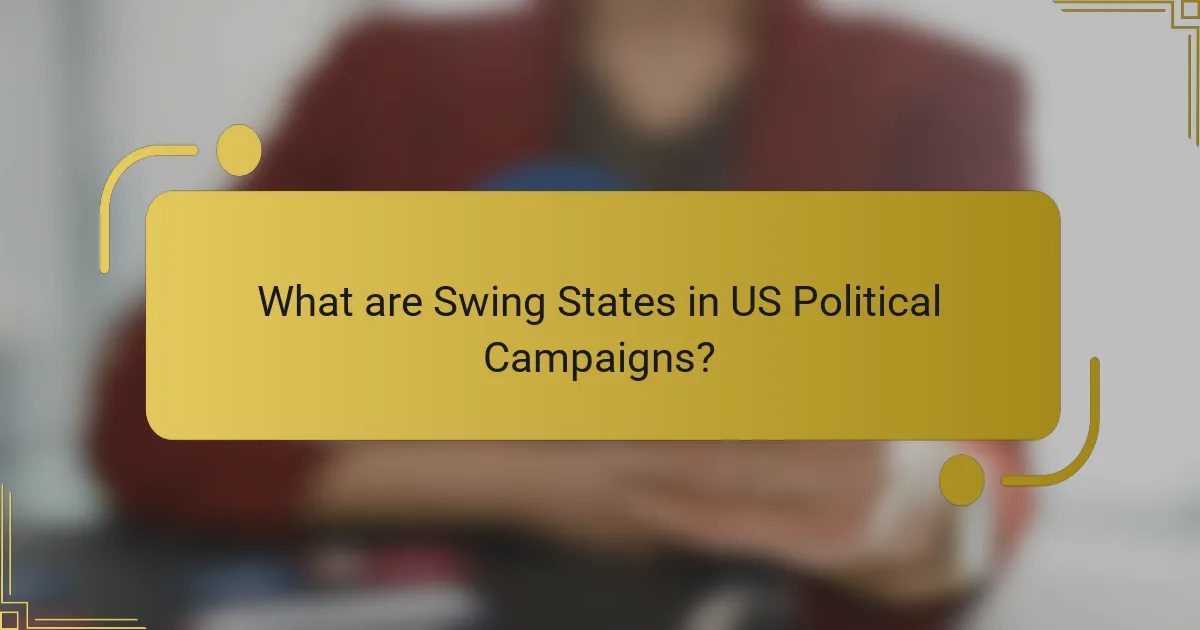Swing states, also known as battleground states, are U.S. states where both major political parties have comparable levels of voter support, making them critical in determining presidential election outcomes. These states, such as Pennsylvania, Michigan, and Wisconsin, often receive heightened attention from candidates due to their unpredictable voting patterns. Campaign strategies in swing states involve targeted messaging, voter outreach, and data analytics to sway undecided voters. Historical trends illustrate the evolving significance of swing states since the late 20th century, highlighting their role in pivotal elections, particularly in the 2000 and 2016 presidential races. Understanding the dynamics of swing states is essential for grasping their impact on U.S. political campaigns.

What are Swing States in US Political Campaigns?
Swing states are states in the U.S. where both major political parties have similar levels of support among voters. These states can significantly influence the outcome of presidential elections. Swing states are also known as battleground states. They often receive more attention from candidates during campaigns. Historical data shows that elections are frequently decided by the votes from these states. In the 2020 election, key swing states included Pennsylvania, Michigan, and Wisconsin. These states often fluctuate between Democratic and Republican candidates in different election cycles. Their unpredictable nature makes them critical for campaign strategies.
How do Swing States differ from other states?
Swing states differ from other states by having no consistent voting pattern in elections. They can be won by either major political party in presidential elections. This unpredictability makes them critical for candidates’ strategies. For instance, in the 2020 election, states like Pennsylvania and Wisconsin were pivotal in determining the outcome. Unlike solidly red or blue states, swing states reflect a more diverse electorate. This diversity often includes a mix of urban and rural voters with varying priorities. Consequently, candidates focus their resources on swing states to maximize their chances of winning.
What factors contribute to a state being classified as a Swing State?
A state is classified as a Swing State based on its electoral unpredictability. Swing States show no consistent support for one political party across elections. They often have a balanced number of registered voters from both major parties. Demographic diversity also plays a significant role in their classification. Economic factors, such as unemployment rates, can influence voter preferences. Historical voting patterns indicate that these states have frequently changed their allegiance. Polling data prior to elections often reflects close contests in Swing States. For example, states like Florida and Ohio have been pivotal in recent presidential elections.
How do demographic trends influence Swing State status?
Demographic trends significantly influence Swing State status by altering voter composition and preferences. Changes in population size, age, ethnicity, and education level can shift political allegiances. For instance, an influx of younger, more diverse populations tends to lean Democratic. Conversely, areas with an aging population may favor Republican candidates.
Historical data shows that states like Florida and North Carolina have become swing states due to increasing Hispanic populations and younger voters. In 2020, Florida’s electorate included 18% Hispanic voters, impacting election outcomes.
Additionally, shifts in urban versus rural populations affect voting patterns. Urban areas typically support Democrats, while rural regions lean Republican. These demographic changes create a dynamic political landscape, making some states more competitive in elections.
Why are Swing States critical in elections?
Swing states are critical in elections because they can be won by either major political party. Their outcomes often determine the overall election results. In the 2020 U.S. presidential election, for example, states like Pennsylvania and Michigan were pivotal. These states have a mix of Democratic and Republican voters, making them unpredictable. Historically, swing states have shifted their support between parties from one election to the next. This volatility makes them prime targets for campaign strategies. Candidates focus their resources heavily on swing states to maximize their chances of winning. The electoral votes from these states can be decisive in close elections.
What role do Swing States play in determining election outcomes?
Swing states are critical in determining election outcomes because they can be won by either major political party. These states often have a mix of demographic and political characteristics that make them unpredictable. For instance, in the 2020 presidential election, states like Pennsylvania, Michigan, and Wisconsin were pivotal in deciding the winner. Historically, elections have been decided by narrow margins in these states, highlighting their importance. In 2016, Donald Trump secured the presidency by winning key swing states that had previously voted for Barack Obama. The electoral votes from swing states can shift the overall balance, making them the focus of campaign strategies. Candidates often allocate significant resources and time to these states to sway undecided voters. Therefore, swing states play a decisive role in shaping the outcome of presidential elections.
How do candidates prioritize Swing States in their campaigns?
Candidates prioritize Swing States by focusing their resources and strategies on these key regions. Swing States are crucial because they can be won by either major political party in elections. Candidates analyze voter demographics, historical voting patterns, and current political trends in these states. They allocate campaign funds, staff, and time to maximize their outreach efforts. Polling data often dictates which Swing States receive more attention. Events such as rallies and town halls are frequently held in these areas to engage voters directly. Additionally, candidates tailor their messages to resonate with local issues and concerns. This targeted approach aims to sway undecided voters in these pivotal regions.

What strategies are employed in Swing State campaigns?
Swing State campaigns employ targeted messaging, voter outreach, and data analytics. These strategies aim to influence undecided voters in crucial states. Campaigns utilize tailored advertisements that resonate with local issues. They also engage in grassroots efforts to mobilize supporters. Additionally, data analytics help identify key demographics and voter behavior patterns. This targeted approach is essential, as swing states can determine election outcomes. Historical examples show that focusing resources in these areas often leads to electoral success.
How do campaign strategies differ in Swing States compared to solid states?
Campaign strategies in swing states focus on persuasion, while solid states emphasize mobilization. Swing states require candidates to appeal to undecided voters. This often involves targeted advertising and tailored messaging. Candidates may visit swing states more frequently to engage with constituents. In contrast, solid states typically have predictable voting patterns. Campaigns in solid states concentrate on ensuring voter turnout. Resources in solid states are allocated to solidify the base rather than sway undecided voters. Historical data shows that swing states can determine election outcomes, making them critical for campaign strategies.
What types of messaging resonate most with Swing State voters?
Messaging that resonates most with Swing State voters includes economic stability, healthcare access, and local issues. Swing State voters often prioritize messages that highlight job creation and economic growth. They respond positively to discussions about affordable healthcare and lowering prescription drug costs. Local issues, such as education funding and infrastructure improvements, also matter significantly. Tailored messaging that addresses specific community needs can enhance voter engagement. Polling data shows that voters in these states often shift based on candidate stances on these topics. For instance, a 2020 survey indicated that 65% of Swing State voters favored candidates who focused on economic recovery post-COVID-19.
How do candidates leverage grassroots movements in Swing States?
Candidates leverage grassroots movements in Swing States by mobilizing local support and fostering community engagement. These movements help candidates build a strong base of volunteers. Volunteers can canvass neighborhoods, distribute campaign materials, and organize events. Grassroots efforts often focus on issues that resonate with local voters. This localized approach increases voter turnout and enhances candidate visibility. For instance, during the 2020 election, candidates utilized grassroots organizations to connect with voters on critical issues like healthcare and education. This strategy proved effective in Swing States, where small margins can determine election outcomes. By engaging with grassroots movements, candidates create a sense of ownership among voters, leading to increased loyalty and support.
What are the key tactics used in Swing State campaigning?
Key tactics used in swing state campaigning include targeted messaging, voter outreach, and data analytics. Campaigns focus on specific issues that resonate with local voters. They employ door-to-door canvassing to engage directly with constituents. Additionally, phone banking and text messaging are utilized to reach a broader audience. Data analytics helps identify key demographics and tailor messages effectively. Campaigns also invest in advertisements that highlight local concerns. Mobilizing volunteers is crucial for grassroots efforts. These tactics are aimed at swaying undecided voters in competitive states, impacting overall election outcomes.
How do candidates use data analytics to target Swing State voters?
Candidates use data analytics to target Swing State voters by analyzing demographic trends and voting behaviors. They collect data on voter preferences, turnout rates, and historical election results. This analysis helps identify key issues that resonate with specific voter segments. Candidates tailor their messaging based on the insights gained. For example, they may focus on economic concerns in a state with high unemployment. Additionally, they use micro-targeting to deliver personalized advertisements to voters. This approach increases engagement and enhances the likelihood of voter turnout. According to a study by the Pew Research Center, data-driven strategies significantly influence election outcomes in competitive states.
What role does advertising play in influencing Swing State voters?
Advertising plays a crucial role in influencing Swing State voters. It shapes perceptions and informs voters about candidates and issues. Targeted advertising can sway undecided voters by highlighting specific policies. In 2020, over $1 billion was spent on advertising in key Swing States. This investment aimed to capture the attention of voters who could tip the electoral balance. Research shows that voters in these states are more responsive to advertisements compared to those in solidly partisan areas. Effective messaging can lead to increased voter turnout and support for a candidate. Thus, advertising is a vital strategy in the competitive landscape of Swing State elections.

What is the historical context of Swing States in US elections?
Swing states are crucial in US elections as they can be won by either major political party. Historically, their significance emerged in the late 20th century. In the 1960s, states like Illinois and California began to show fluctuating voting patterns. This trend continued into the 1980s, with states like Florida and Ohio gaining prominence. The 2000 election highlighted the importance of swing states, as Florida determined the outcome. The 2016 election further emphasized this, with states like Wisconsin and Pennsylvania flipping from Democrat to Republican. Analyzing voting behavior in these states reveals their pivotal role in shaping presidential elections.
How have Swing States evolved over recent election cycles?
Swing states have become increasingly volatile in recent election cycles. Their voting patterns have shifted more dramatically than in the past. This volatility can be attributed to demographic changes and shifts in party alignment. States like Florida and Pennsylvania have seen significant swings in voter preference. For example, Florida voted for Obama in 2008 but swung to Trump in 2016. In 2020, it remained a Trump stronghold. Additionally, suburban areas in swing states have leaned more towards Democrats in recent elections. This trend reflects changing attitudes on issues like healthcare and immigration. The evolution of swing states highlights the dynamic nature of American electoral politics.
What significant shifts in voter behavior have been observed in Swing States?
Significant shifts in voter behavior in Swing States include increased partisan polarization and changes in demographic voting patterns. In recent elections, voters have shown stronger allegiance to their respective parties. This trend is evident in states like Pennsylvania and Wisconsin, where the gap between Democratic and Republican support has widened. Additionally, suburban voters have increasingly leaned Democratic, while rural areas have become more Republican. According to the Pew Research Center, 2016 and 2020 elections highlighted these shifts, with suburban areas showing a 10% increase in Democratic support. Furthermore, younger voters have become more engaged, influencing outcomes in key Swing States. These behavioral changes reflect broader national trends in voter alignment and engagement.
How have demographic changes impacted the political landscape of Swing States?
Demographic changes have significantly influenced the political landscape of Swing States. Shifts in population, including migration patterns, have altered voter demographics. For instance, an influx of younger, more diverse populations often leans Democratic. Conversely, areas experiencing population decline may retain more conservative voting patterns. Census data shows that states like Arizona and Georgia have seen increased urbanization and diversity, impacting election outcomes. In the 2020 election, these demographic shifts contributed to Joe Biden winning in traditionally Republican states. Additionally, changing attitudes on issues like immigration and healthcare among new residents have reshaped party platforms. Overall, demographic changes are central to understanding electoral dynamics in Swing States.
What lessons can be learned from past Swing State campaigns?
Past Swing State campaigns reveal several key lessons. First, targeting specific demographics is crucial. Campaigns that effectively engage independent voters often succeed. Second, local issues can outweigh national narratives. Candidates who address state-specific concerns resonate better with voters. Third, ground game efforts are essential. High voter turnout in swing states often results from robust grassroots mobilization. Fourth, the use of data analytics improves campaign strategy. Campaigns that analyze voter behavior can tailor their messages effectively. Lastly, adaptability is vital. Successful campaigns pivot strategies based on real-time feedback and changing voter sentiments. Historical examples, such as the 2000 Florida election, underscore these lessons through their impact on outcomes.
How can understanding historical trends improve future campaign strategies in Swing States?
Understanding historical trends can significantly enhance future campaign strategies in Swing States. By analyzing past election results, campaigns can identify voter behavior patterns. For instance, historical data shows that demographic shifts impact voting outcomes. In the 2020 election, suburban voters in key Swing States shifted towards Democrats, influenced by issues like healthcare and education.
Campaigns can also leverage historical turnout rates to allocate resources effectively. In 2016, states like Michigan and Wisconsin had lower voter turnout compared to previous elections. Understanding these trends allows campaigns to target outreach efforts to increase participation.
Moreover, historical analysis of campaign messaging reveals which issues resonate with voters. For example, economic concerns were pivotal in the 2008 election. By recognizing these trends, campaigns can tailor their messages to align with current voter priorities.
Ultimately, understanding historical trends equips campaigns with actionable insights to navigate the unique political landscape of Swing States.
What common pitfalls should candidates avoid when campaigning in Swing States?
Candidates should avoid alienating moderate voters when campaigning in Swing States. Swing States often have diverse political views. Focusing too heavily on extreme positions can push potential supporters away. Additionally, candidates should not neglect local issues that matter to constituents. Ignoring these concerns can lead to a disconnect with voters. Misunderstanding the demographic makeup is another common pitfall. Each Swing State has unique characteristics that require tailored messaging. Lastly, candidates should avoid negative campaigning that lacks substance. Voters in Swing States often respond better to positive, solution-oriented messages.
What are best practices for engaging Swing State voters effectively?
To engage Swing State voters effectively, campaigns should focus on targeted messaging and personal outreach. Tailoring messages to address local issues resonates with voters. Utilizing data analytics can identify voter preferences and behaviors. Door-to-door canvassing creates personal connections and builds trust. Engaging through social media platforms allows for direct interaction and real-time feedback. Hosting community events fosters a sense of involvement and encourages voter participation. Research indicates that personalized voter engagement increases turnout by 20%. Mobilizing grassroots efforts can amplify campaign reach and impact.
How can candidates build authentic connections with Swing State constituents?
Candidates can build authentic connections with Swing State constituents by engaging in active listening and understanding local issues. They should participate in community events to demonstrate genuine interest. Direct communication through town halls fosters trust and transparency. Utilizing social media allows for real-time interaction with constituents. Tailoring messages to reflect local values enhances relatability. Research indicates that candidates who prioritize personal interactions see increased voter engagement. For example, a study by the Pew Research Center shows that 70% of voters value face-to-face communication with candidates. This approach not only builds rapport but also encourages voter loyalty.
What outreach strategies have proven successful in Swing State elections?
Targeted voter outreach has proven successful in Swing State elections. This includes personalized communication strategies, such as door-to-door canvassing and phone banking. Data-driven approaches help identify key demographics and tailor messages accordingly. Engaging local influencers and community leaders enhances credibility and reach. Utilizing social media platforms effectively mobilizes younger voters. Additionally, ground game efforts, such as organizing rallies and events, foster community involvement. Research shows that these strategies can significantly increase voter turnout in competitive regions. For example, the 2018 midterm elections highlighted the effectiveness of grassroots mobilization in Swing States like Pennsylvania and Wisconsin.
Swing states are pivotal regions in U.S. political campaigns where both major parties hold similar levels of voter support, significantly influencing presidential election outcomes. This article explores the characteristics that define swing states, including their electoral unpredictability and demographic diversity, as well as the strategies candidates employ to engage voters in these critical areas. It also examines historical trends, shifts in voter behavior, and best practices for effective outreach, highlighting the importance of understanding local issues and tailoring messages to resonate with constituents. By analyzing the dynamics of swing states, the article provides insights into their role in shaping electoral results and guiding campaign strategies.



